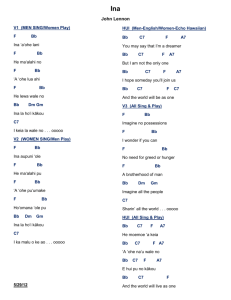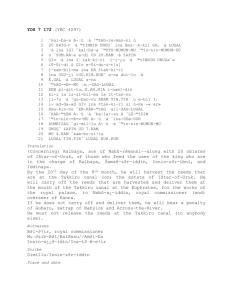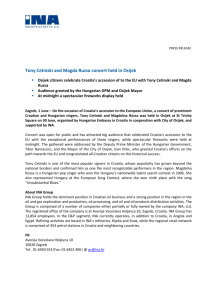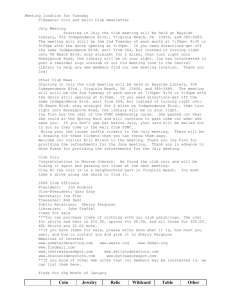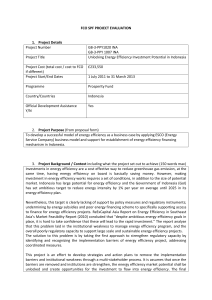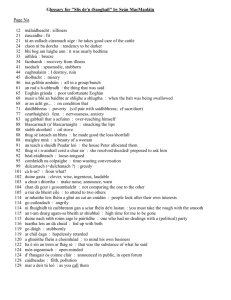Effect of divorce from anchor relative
advertisement
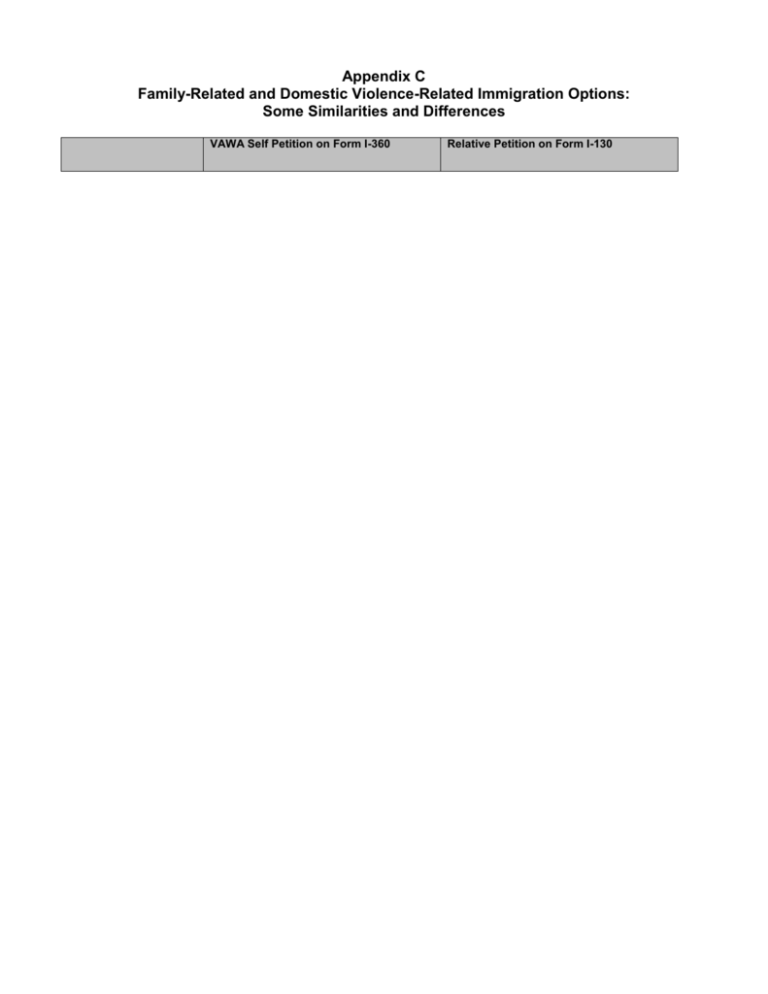
Appendix C Family-Related and Domestic Violence-Related Immigration Options: Some Similarities and Differences VAWA Self Petition on Form I-360 Relative Petition on Form I-130 VAWA Self Petition on Form I-360 Relative Petition on Form I-130 Petitioner The intending immigrant herself files the VAWA self-petition and controls the process. The USC or LPR family member files the Relative Petition and may withdraw any time up until the moment permanent resident status is granted. Immigration status of anchor relative at time of filing USC; USC;4 LPR; LPR former USC where immigration status lost in the previous two years because of domestic violence1 former LPR where immigration status lost in the previous two years because of domestic violence2 or deceased USC deceased USC spouse where death occurred in the last two years3 Effect of pre-filing termination or nonexistence of marital relationship Pre-filing, a divorce will not prevent eligibility for filing a VAWA self-petition where the divorce takes place in the two years immediately proceeding the filing and there is a connection between the divorce and the domestic violence.5 Prevents eligibility. Pre-filing lack of marital relationship due to previously unknown bigamy does not change eligibility for a VAWA selfpetition.6 1 2 3 4 5 6 INA §204(a)(1)(A)(iii)(II)(aa)(CC)(bbb) (spouse of former USC); INA §204(a)(1)(A)(iv) (child of former USC). INA §204(a)(1)(B)(ii)(II)(aa)(CC)(aaa) (spouse of former LPR); INA §204(a)(1)(B)(iii) (child of former LPR). INA §204(a)(1)(A)(iii)(II)(aa)(CC)(aaa) (widowed spouse of deceased USC). NB: Although non-citizens whose spouses have died may not file Relative Petitions, they are eligible to self-petition as widows. INA §201(b)(2)(A)(i). INA §§ 204(a)(1)(A)(iii)(II)(aa)(CC)(ccc)(USC) & (B)(ii)(II)(aa)(CC)(bbb) (LPR); see also Memorandum from Stuart Anderson, Exec. Assoc. Comm'r, to Michael Pearson, Exec. Assoc. Comm'r, File No. HQADN/70/8, Eligibility to Self-Petition as a Battered Spouse of a U.S. Citizen or Lawful Permanent Resident Within Two Years of Divorce (Jan. 2, 2002), available at http://www.asistaonline.org/legalresources/I-360Self-Petitiondocs/Policy_Memos/Pearson_-_1-2-02.pdf. See INA §§ 204(a)(1)(A)(iii)(II)(aa)(BB) (USC) & (B)(ii)(II)(aa)(BB) (LPR); see also Memorandum from Johnny N. Williams, Exec. Assoc. Comm’r, to Regional Directors, Deputy Exec. Assoc. Comm’r, INS, File No. HQADN/70/8, Eligibility to Self-Petition as an Intended Spouse of an Abusive U.S. Citizen or Lawful Permanent Resident (Aug. 21, 2002), available at http://www.asistaonline.org/legalresources/I-360SelfPetitiondocs/Policy_Memos/Williams_-_8-21-02.pdf; also available at AILA InfoNet Doc. No. 02091042 (posted Sep. 10, 2002). Ongoing familial relationship with USC or LPR anchor relative VAWA Self Petition on Form I-360 Relative Petition on Form I-130 Post-filing loss of status by anchor relative does not affect the validity of the VAWA self-petition7 The Relative Petition will be automatically revoked12 upon: Post-filing divorce from anchor relative does not affect the validity of the VAWA self-petition8 Loss of immigration status of the petitioner; Divorce between petitioner and beneficiary; Post-filing death of anchor USC relative post-filing does not affect the validity of the VAWA self-petition.9 Marriage of beneficiary where marriage ends beneficiary’s eligibility as an immediate or preference relative; Post-approval remarriage or marriage of VAWA10 Aging-out13 Post-lack of marital relationship due to previously unknown bigamy does not change validity of VAWA self-petition.11 Death of Petitioner;14 Employment authorization Upon approval of the I-360, the approved VAWA self-petition is eligible to work incident to status.15 The approval of the I-130 grants no employment authorization benefits.16 Lawful presence in the United States Upon approval of the I-360, a VAWA selfpetitioner is allowed to remain in the United States (if already present) and is granted deferred action, making her lawfully present.17 The approval of an I-130 does not grant a non-citizen the right to be in the United States.18 7 8 9 10 11 12 13 14 15 16 17 INA §204(a)(1)(A)(vi) (spouses and children of USCs); INA §204(a)(1)(B)(v)(I) (spouses and children of LPRs) Id. INA §204(a)(1)(A)(vi). INA §204(h). See INA §§ 204(a)(1)(A)(iii)(II)(aa)(BB) (USC) & (B)(ii)(II)(aa)(BB) (LPR); see also Memorandum from Johnny N. Williams, Exec. Assoc. Comm’r, to Regional Directors, Deputy Exec. Assoc. Comm’r, INS, File No. HQADN/70/8, Eligibility to Self-Petition as an Intended Spouse of an Abusive U.S. Citizen or Lawful Permanent Resident (Aug. 21, 2002), available at http://www.asistaonline.org/legalresources/I-360SelfPetitiondocs/Policy_Memos/Williams_-_8-21-02.pdf; also available at AILA InfoNet Doc. No. 02091042 (posted Sep. 10, 2002). 8 CFR §205.1 Some children are protected from aging out upon turning 21 under INA §201(f) or INA §203(h). Under certain circumstances, USCIS may choose to allow a beneficiary of a Relative Petition to obtain lawful permanent resident status after the death of the petitioner (called humanitarian reinstatement). See 8CFR § 205.1(a)(3)(i)(C); see also INA § 212(a)(4)(C)(ii) and INA §213A(f). INA §204(a)(1)(K), added by section 814(b) of the Violence Against Women and Department of Justice Reauthorization Act of 2005, Pub. L. No. 109-162, 119 Stat. 2960 (Jan. 5, 2006). Current practice, based on pre-January 5, 2006 law, includes filing an Application for an Employment Authorization Document (EAD) on Form I-765 to obtain an EAD. At the time of this writing, it is unclear whether the separate filing of an Application for an EAD on Form I-765 will continue to be a requirement once INA §204(a)(1)(K) has been implemented. But cf. INA§101(a)(15)(V) and INA §214(q)(a limited exception for Preference Category 2A I-130 beneficiaries who had pending or approved I-130s before Dec. 21, 2000). See Memorandum from Michael D. Cronin, Acting Exec. Assoc. Comm’r, to Vermont Service Center, File No. HQ/ADN70/6.1P, Deferred Action Determinations for Self-petitioning Battered Spouses and Children, (Sep. 8, 2000), available at http://www.asistaonline.org/legalresources/I-360SelfPetitiondocs/Policy_Memos/Cronin_-_9-8-00.pdf and reprinted in 77 Interpreter Releases 1432 (Oct. 2, 2000); with respect to certain children, see . INA §204(a)(1)(D)(i)(II) & (IV). VAWA Self Petition on Form I-360 Relative Petition on Form I-130 Derivative children Derivative children are included by operation of law for both immediate relatives and preference relatives. Derivative children are included by operation of law only for preference relatives. Age-Out Protections Protected by the provisions of the Child Status Protection Act,19 Protected by the provisions of the Child Status Protection Act21 Children of USCs allowed to petition up to age 25 as if they were children under 21 if there is connection between late-filing and domestic violence.20 Good moral character Good moral character is required of all VAWA self-petitioners and the statute provides no limit on the time period which federal immigration authorities may consider good moral character.22 There is no good moral character requirement. Adjustment of Status Approved VAWA self-petitioners are eligible to adjust status under INA §245(a), regardless of entry without inspection (EWI) or any of the prohibitions to adjustment enumerated in INA §245(c), including unlawful employment or visa overstay. INA §245(i), and the fines paid pursuant to that provision, are irrelevant to VAWA selfpetitioners. Immediate relatives cannot adjust status under INA §245(a) if they entered without inspection and are not eligible for relief under INA §245(i). 18 19 20 21 22 Preference relatives cannot adjust status under INA §245(a) if they entered without inspection or are prevented from adjustment under INA §245(c) for such acts as unlawful employment, visa overstay or any other delineated act if they are not eligible for relief under INA §245(i). But cf. INA§101(a)(15)(V) and INA §214(q)(a limited exception for Preference Category 2A I-130 beneficiaries who had pending or approved I-130s before Dec. 21, 2000). Pub. L. 107-208, 115 Stat. H.R. 1209 (Aug. 6, 2002); children covered by VAWA legislation are explicitly included by Sec. 805(b) of the Violence Against Women and Department of Justice Reauthorization Act of 2005, Pub. L. No. 109-162, 119 Stat. 2960 (Jan. 5, 2006). INA §204(a)(1)(D)(v). Pub. L. 107-208, 115 Stat. H.R. 1209 (Aug. 6, 2002). INA §204(1)(A)(iii)(II)(bb) (spouses of USCs); INA §204(1)(A)(iv) (children of USCs); INA §204(1)(B)(ii)(II)(bb) (spouses of LPRs); INA §204(1)(B)(iii) (children of LPRs). Self-petitioners are required to provide affirmative evidence of good moral character for the three year period immediately prior to filing. 8 CFR §204.2(c)(2)(v) (spouses of USCs and LPRs) and 8 CFR §204.2(e)(2)(v) (children of USCs and LPRs). Despite the seeming three-year limitation on looking back at good moral character, in my experience as an attorney at Sanctuary for Families, I found that the Vermont Service Center routinely denies VAWA self-petitions based on lack of good moral character for conduct that occurred prior to the three-year period. Whether or not such denials are lawful (see, e.g. Santamaria-Ames v. INS, 104 F.3d 1127, 1131 & 1133, n.8 (9th Cir. 1996) (holding that while “conduct predating the regulatory period . . .may be considered . . . in determining naturalization eligibility,” such “conduct prior to the regulatory period” cannot “be the sole basis for finding lack of good moral character”) is unclear, but to my knowledge such denials have not yet been challenged in federal court. Petition to Remove Conditions on Residence (Battered Spouse/Child Waiver) on Form I-751 Petition to Remove Conditions on Residence (Joint Petition) on Form I-751 Petition to Remove Conditions on Residence (Battered Spouse/Child Waiver) on Form I-751 Petition to Remove Conditions on Residence (Joint Petition) on Form I-751 Petitioner Only the conditional resident is a petitioner.23 The spouse or parent who initially filed the Relative Petition on Form I-130 files as a petitioner jointly with the conditional resident24 Effect of death of spouse/parent None Death creates a separate ground for waiving joint-filing requirement. Effect of Divorce None Divorce creates a separate ground for waiving joint-filing requirement. Employment authorization Employment authorization is incident to status as a conditional resident;25 such status continues automatically during the pendency of the Battered Spouse/Child Waiver.26 Employment authorization is incident to status as a conditional resident;27 such status continues automatically during the pendency of the Joint Petition.28 Lawful presence in the United States Lawful presence is incident to status as a conditional resident; such status continues automatically during the pendency of the Battered Spouse/Child Waiver.29 Lawful is incident to status as a conditional resident; such status continues automatically during the pendency of the Joint Petition.30 Ability to travel in and out of the United States Traveling in and out of the United States is incident to status as a conditional resident; such status continues automatically during the pendency of the Battered Spouse/Child Waiver.31 Traveling in and out of the United States is incident to status as a conditional resident; such status continues automatically during the pendency of the Battered Spouse/Child Waiver.32 Derivative children Derivative children are included only if they received conditional status concurrently or within 90 days of the parent receiving such status.33 Derivative children are included only if they received conditional status concurrently or within 90 days of the parent receiving such status.34 Time to file A Battered Spouse or Child Waiver may be filed at any time.35 90 days prior to the two year anniversary of the grant of status.36 23 24 25 26 27 28 29 30 31 32 33 34 35 INA §216(c)(4)(C). INA §216(c)(1)(A). 8 CFR §274a.12(a)(1) (“An alien who is a lawful permanent resident (with or without conditions pursuant to section 216 of the Act), as evidenced by Form I–551 issued by the Service. An expiration date on the Form I–551 reflects only that the card must be renewed, not that the bearer’s work authorization has expired”). 8 CFR §216.4(a)(1). 8 CFR §274a.12(a)(1) (“An alien who is a lawful permanent resident (with or without conditions pursuant to section 216 of the Act), as evidenced by Form I–551 issued by the Service. An expiration date on the Form I–551 reflects only that the card must be renewed, not that the bearer’s work authorization has expired”). Id. 8 CFR §216.4(a)(1. Id. Id. Id. 8 CFR §216.4(a)(2). Id. The explicit requirement that a petition to remove conditions must be filed within the 90 day window prior to the two year anniversary of the grant of conditional status described in INA §216(d)(2) applies only to joint petitions filed pursuant to INA §216(c)(1). This point is frequently lost on both mail room staff and adjudications officers but nonetheless is the law. Sanctuary for Families has successfully filed Battered Spouse Waivers on behalf of non-citizens even after such status has been affirmatively terminated by 36 federal immigration authorities and as late as a dozen years past the initial two-year grant of conditional permanent resident status. INA §216(d)(2). Application for Cancellation of Removal and Adjustment of Status for Certain Nonpermanent Residents on Form EOIR 42B for certain domestic violence victims (VAWA Cancellation) Application for Cancellation of Removal and Adjustment of Status for Certain Nonpermanent Residents on Form EOIR 42B (10–year Cancellation) Application for Cancellation of Removal and Adjustment of Status for Certain Nonpermanent Residents on Form EOIR 42B for certain domestic violence victims (VAWA Cancellation) Application for Cancellation of Removal and Adjustment of Status for Certain Nonpermanent Residents on Form EOIR 42B (10–year Cancellation) Applicant Non-citizen facing removal Non-citizen facing removal Immigration status of anchor relative at time of filing USC; USC; or LPR; LPR38 former USC; former LPR; deceased USC; deceased LPR37 Relationship with anchor relative Current spouse; Current spouse; Former spouse; Current parent; Current parent; Current child Former parent; USC/LPR (current or former) with whom the applicant has a child in common where USC/LPR abused child. Effect of death of anchor spouse/parent/child None Ends eligibility Effect of divorce from anchor relative None Ends eligibility Employment authorization Employment is eligible to apply for authorization during the pendency of the application.39 Employment is eligible to apply for authorization during the pendency of the application.40 Nature of required hardship Extreme hardship41 Exceptional and extremely unusual hardship42 Who must suffer the hardship? VAWA cancellation applicant; Current USC/LPR spouse; Child; Current USC/LPR parent; Current USC/LPR child44 Parent43 Derivative children None None Effect of age or current marital status of applicant whose anchor relative is a parent None None Good moral character Required for three years prior to application. Required for ten years prior to application 37 38 39 40 41 42 43 44 The conclusion that current immigration status is not a requirement is based on the use of the phrases “is or was a United States citizen,” INA §240A(b)(2)(A)(i)(I) and “is or was a lawful permanent resident,” INA §240A(b)(2)(A)(2)(i)(II). In addition, the repeated use of the present progressive “has been” throughout INA §240(2) suggests that past actions alone may be the basis for eligibility. The conclusion that current immigration status is required for 10-year Cancellation is based on the language of INA §240A(b)(1)(D) which states that there must be hardship to a qualifying relative “who is a citizen of the United States or an alien lawfully admitted for permanent residence.” (emphasis added) 8 CFR §274a.12(c)(10). Id. INA §240A(b)(2)(A)(v). Note that special hardship factors for those seeking VAWA suspension of deportation (and presumably, by analogy, VAWA cancellation) are listed at 8 CFR §1240.58(c). INA §240A(b)(1)(D). INA §240A(b)(2)(A)(v). INA §240A(b)(1)(D).
